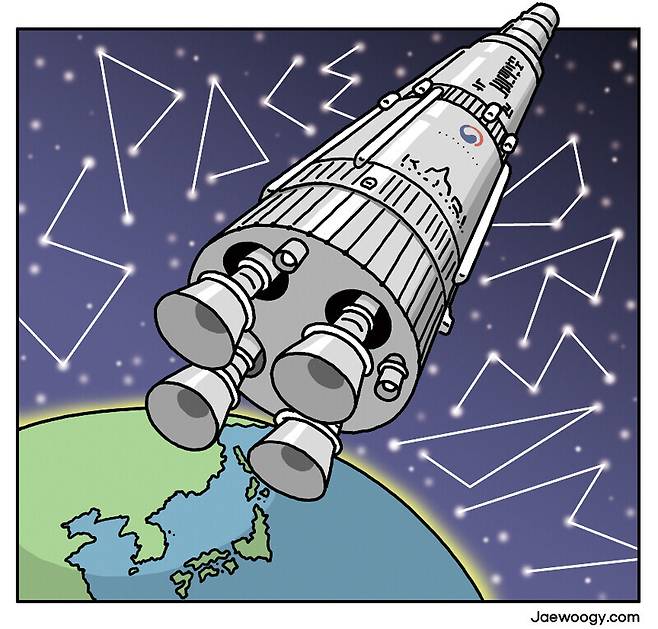[Column] What S. Korea's Nuri rocket carries with it into space
이 글자크기로 변경됩니다.
(예시) 가장 빠른 뉴스가 있고 다양한 정보, 쌍방향 소통이 숨쉬는 다음뉴스를 만나보세요. 다음뉴스는 국내외 주요이슈와 실시간 속보, 문화생활 및 다양한 분야의 뉴스를 입체적으로 전달하고 있습니다.

The South Korean Nuri carrier rocket is scheduled for a launch on Oct. 21 from the Naro Space Center in Goheung, South Jeolla Province.
Development of the Nuri began in 2010, with the design, production, testing, and launch management all based on domestic technology.
The first stage of the rocket combines four 75-ton liquid fuel engines to produce 300 tons of thrust, with a second stage consisting of one 75-ton engine and a third stage consisting of one seven-ton engine. At the tip is a 1.5-ton model satellite.
If the launch is successful, it will place South Korea among the ranks of countries with the ability to place a 1.5-ton working satellite into an orbit 600 to 800km above the earth’s surface.
Space technology has direct ties to military capabilities with intercontinental ballistic missiles (ICBMs) and intelligence satellites, but it also has profound ripple effects in a wide range of other areas.
Microwave ovens were first developed to prepare meals on spaceships without the need for an open flame. Other examples of commercialized space technology include water purifiers, self-driving capabilities, navigation, vacuum cleaners, air purifiers, Gore-Tex, memory foam, freeze-dried food, and excimer lasers.
The digital image signal processing technology developed to transmit photographs taken in space is a key technology responsible for the digital world. According to NASA, over 1,800 different technological products as of 2012 were derived from space technology.
The Nuri consists of some 300,000 components and involved a budget of approximately 2 trillion won (US$1.7 billion).
While space exploration is motivated by military aims and the development of advanced technology, it also inspires dreams of the infiniteness signified by space and things that exist beyond our reality.
The Voyager 1 and 2 spacecraft, which were launched by NASA in 1977 to explore interstellar space beyond the solar system, included “Golden Records” meant to introduce Earth to extraterrestrial life.
While some opposed this as a dangerous move that could provoke an invasion of the earth, “Cosmos” author Carl Sagan — a leader of the project — said, “The spacecraft will be encountered and the record played only if there are advanced spacefaring civilizations in interstellar space. But the launching of this bottle into the cosmic ocean says something very hopeful about life on this planet.”
The Golden Records on the Voyager spacecraft represented a message and affirmation and hope toward the people of Earth.
In his “Harbor Journey,” poet Kwak Jae-gu writes that the name of every tiny fishing boat in the harbor speaks to the dreams and longing of its owner. The name of the Nuri — a Korean word meaning “world” — which was selected through a nationwide contest, expresses the dreams of our world expanding beyond the Earth and into the universe.
By Koo Bon-kwon, senior staff writer
Please direct questions or comments to [english@hani.co.kr]
Copyright © 한겨레신문사 All Rights Reserved. 무단 전재, 재배포, AI 학습 및 활용 금지
- 윤석열씨, 정치 그만두시오
- 김웅의 “저희, 우리”는 누구?…공수처는 ‘검찰 그분’ 찾고 있다
- 심상정 “설계한 자=죄인” vs 이재명 “공공환수 설계한 착한사람”
- [단독] 생수 마시고 쓰러진 직원, 결근 뒤 숨진 동료…같은 팀 확인
- 표지판 없어도…‘어린이 보호구역’ 주정차 내일부터 전면금지
- 신해혁명 쌍십절 축제 사라진 홍콩…오성홍기의 ‘붉은 경고’만 펄럭여
- [생중계 국감] ‘대장동 2차전’ 이재명 경기지사 vs 국민의힘
- 한-미, 종전선언 문안 협의중…미, 입장 공개할까
- 법원, 택배노조 집회 허용…“서울시 집회 전면금지, 과도한 제한”
- 경찰, ‘9층 창밖’ 던진 유동규 아이폰 수리·잠금해제 완료